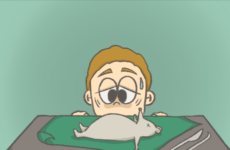It is not uncommon for athletes to get injured. Some would even say that it’s part of the job description. After all, in any physical sport there is the inherent risk of bodily harm, whether it be minimal or extensive. Despite this, however, injury is still the dread of any athlete because it can hurt far more than just one’s body.
An injury in an athlete’s life is so much more than a small hiccup. Not only does an injury harm the body of an athlete, but it also harms her psyche. From personal experience, injuries discourage an athlete and spur negative thinking. Coping with a serious injury is physically very difficult, but the mental pain proves far worse to cope with.
Two months into my freshman year, I suffered a serious knee injury. The season for my primary sport was just around the corner, and it seemed I would have to sit it out. I had never suffered an injury that was serious enough for me to sit out a season. Now, because of one blunder, I had multiple doctors telling me that I had to take a break. I was devastated.
Long-term rehab’s meaning is in the name — a doctor will prescribe a course of action that combines extensive physical therapy and time off. It should be obvious why athletes hate this. Most Choate athletes will do their physical therapy with the on-call physical therapist who comes in biweekly. They do some exercises, ice, “electric stim”, and call it a day. The injured athlete can’t do anything too strenuous. It’s quite the change for competitive athletes who aren’t used to slowing down.
Time off, even with little exercise, leaves your body weaker. In the case of swimming, it takes one week to make up for one day of lost pool time, and I am sure similar ratios exist for other sports.
When an athlete is injured, more than just a specific body part is hurt. One of the leading stressors for athletes is the risk of injury; therefore, injury comes with increased anxiety. As one who was once injured, I can say that being “out” for any amount of time increases worrying and insecurities.
This is especially true for people who want to continue their career in college. A history of injury can look bad to a coach, only adding to the pressure faced by athletes. Deep down, every athlete knows that time off, especially recovery time, is good in the long run.
However, in the age of the unending “grind,” it is hard to look at the bigger picture. An athlete’s life surrounds her craft, and the possibility of giving that up is too real. Long-term rehabilitation is one of the hardest things for an athlete to undergo because its effects never really go away. You never are the same athlete you were before the injury.
In my experience, with my rehab still continuing two years after my injury, long-term rehabilitation is scary. It causes a lot of fear and doubt, but, in the end, it is the best thing for your body. While rehab is not desirable in any way, it is important to take proper care of your body, especially if it means addressing and working through an injury.





